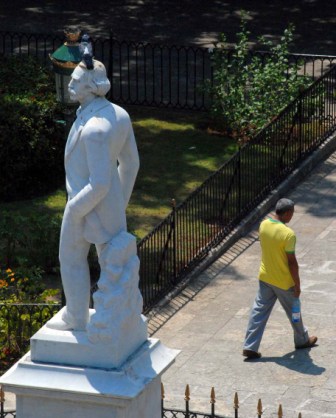Cash to Cuba

HAVANA TIMES, June 28 (IPS) – When Cuban dentist T. Alonso, 45, opened the envelope sent to him by his cousin Adelina from Miami, he felt “cheated.” “Instead of 100 dollars, as she had promised, she only sent me 20,” he complained.
“She wrote me a few brief lines explaining she still hasn’t found a job, and that she and her husband still can’t make ends meet, though he has a decent income since he’s been there a long time. In addition, Adelina has to send money to her two children she left in Cuba; they’re university students and need many things,” he added.
Alonso said he receives the cash through a woman named Pilar who has been shuttling back and forth to Cuba several times a year, even “since before the Barack Obama administration,” he commented.
“She always comes loaded with money for different families. I suppose she charges them a good slice because she’s been doing it for quite a while. People like her are called ‘mules,’ but instead of drugs they bring dollars.”
All of the remittances that legally enter the island are managed by the Cimex Corporation through its financial section (Cubapack) under an agreement with US firm Western Union. Cimex president Eduardo Bencomo disclosed recently that the amount of these remittances received has declined over the past several weeks; he attributed this situation to the world economic crisis having forced people to send less family assistance.
Through Cubapack, between $300 million and $400 million arrive annually to the island via legal routes. It is estimated that the total amount of remittances would add up to $1.4 billion annually if one were to include those funds arriving through “unofficial” means, such as through friends and traffickers.
A survey carried out by the Washington-based Inter-American Dialogue interviewed 500 Cubans (300 in the United States and 200 in the island) between December 2008 and January of this year. This poll concluded that Cuba receives between $830 million and $985 million annually through family remittances.
The organization conducted the study prior to US President Barack Obama announcing the relaxation of restrictions imposed in 2004 by the George W. Bush administration. Inter-American Dialogue specialist Manuel Orozco said nearly 40% of the remittances from the US are sent by informal means, which doesn’t allow accurate calculations of the real amount of money that enters the island every year.
The calculation is close to $983 million, a figure disclosed in 2007 world report on remittances sponsored by the International Fund for Agricultural Development of the United Nations (in which Orozco also participated) along with the Multilateral Fund of Investments of the Inter-American Development Bank.
According to that report, this estimate is modest when compared to the aggregate value of the island’s foreign commerce, which surpassed $20 billion dollars in imports and exports in 2008.
Nevertheless, such additional income could be relevant in moments of tight foreign currency shortage due to the rise in imports and the fall of exports, a tendency that became worse in the first quarter of this year, confirmed Rodrigo Malmierca, the minister of Foreign Trade and Investment, when presenting awards to the best exporting entities of 2008.
End of Bush Era Lessens Restrictions
In 2004, the Bush administration restricted money transfers to a maximum of $300 per quarter and only to direct family members (children, parents and siblings). However, on April 13 of this year President Obama announced the elimination of limits on both the amounts and the frequency in which funds could be sent. Moreover, he expanded the definition of relatives to include those who are even twice removed (e.g., cousins, great-grandchildren).
In statements to the Mexican newspaper La Jornada on April 23, Orozco pointed out that with the elimination of the US restrictions, the number of people who send money to Cuba is expected to increase by between 50-60%, while the average volume could rise from $150 dollars to $200, which would situate Cuba at the level of other Caribbean countries such as Haiti, Jamaica, the Dominican Republic and Guyana.

The expert from Inter-American Dialogue projects that the economic crisis will have a net neutral effect, arguing that while unemployment and falling wages in the United States generally influence senders, in the case of Cubans this will be compensated by the “positive or leveling effect” of the recent elimination of restrictions.
The measures, publicized on April 13 by President Barack Obama to alleviate the blockade of Cuba, still have not had an impact on the remittances from that country to the island. Moreover, those funds are even expected to decline this year due to the financial crisis, according to press reports about the Cimex director’s statements.
The Cuban administrator pointed out that the impact of Obama’s statement has still not been felt because “these measures have to be technically implemented to make them legal.” Bencomo explained that the total figure for remittances is difficult to specify because “a significant volume” of money arrives through informal channels, although he recognized that those funds received by Cubapack this year are less than those in previous years.
For Pedro Hernandez and Ana Luisa Gonzalez, both 80 and married for 50 years, the money their 35-year-old son sends them has increased rather than declined with the economic crisis, according to the couple. In their opinion, “Since people can no longer buy new cars, they are increasingly fixing their cars, so our son (an auto mechanic) has more work. Before the money transfers were more sporadic, now he sends $100 every three months through friends who come to Cuba.”
But this couple’s case is hardly the most common. Most of the interviewees reported that the amount of money transferred from their relatives has declined, with some claiming not even being able to raise enough money for their fare to the island. Elisa Sanchez has not been able to see her mother Mercedes, who six months ago had one of her breasts removed because of cancer.
Another revealing fact in the Inter-American Dialogue survey was that while 81% of the Cubans interviewees had at least one relative in the United States in 2005, by the beginning of this year the figure had dropped to 61%. Notwithstanding, emigration toward the US did not decline between 2000 and 2009: more than 200,000 Cubans were legally admitted in that period, not to mention those who arrived by other means.
To Satisfy Basic Needs
“I’m the one who does the shopping, and everything goes for food, soap, detergent, and mopping towels,” said Olga Campos, who receives money from her son every six months. This downtown Vedado district resident added, “My husband’s pension is only 242 Cuban pesos ($12 USD), and that doesn’t go very far. Medicine is cheap, but we have to buy a lot of it for the treatment of my husband’s heart.”
“In addition, there are gifts that we give to the doctors who treat us. It’s a miracle that my husband is alive; he had a third heart attack when he found out that our son had left on an illegal speedboat five years ago,” said the 78-year-old homemaker.
Cubans tend to emigrate for economic reasons, as the research of the Washington-based organization evidenced. The three basic factors are: to improve the life of the family (38%), low wages (26%), and to help with remittances (21%), motivations that correspond to those of other Central American and Caribbean emigrants.
Carmen Ojeda, a former clerk who retired on her doctor’s advice – but with a monthly pension of only 200 pesos ($10 USD) – survives thanks to her aunt Raquel. Describing the aunt, Carmen said, “She’s a real fighter. Though she can’t send me money, every so often she sends containers full of clothes so that I can sell them or distribute them among the family members, and there are a lot of us.”
“I don’t know how she gets them to us. We get a call from a person and they tell us what day someone should stay at home. Sometimes they take a while, but they always come,” she added.

According to University of Miami economist Jorge Salazar-Carrillo, his sources in Havana estimate that 48% of the Cuban population receives family remittances, and although unanimity doesn’t exist with regard to that figure, it is generally recognized that the total amount of money sent is significant and that a large number of people subsist thanks to it.
The research found that 56% of the remitters from the United States use only the formal channel recognized by both countries (Western Union), while 43% use travelers (“mules”), who lend their services informally.
This 56% could in fact be a smaller figure, influenced by the fear of not revealing other means approved by the United States government, although the survey was anonymous.
In addition to mules, the study didn’t address other irregular methods established in accordance with US law, such as the one described by 80-year-old María Gutierrez. She explained that her daughter gives $125 to a person in Miami and she receives $100 in convertible pesos ($80 USD) “in my house.” In her opinion, this involves “an agency or private business.”
The recession has not influenced the amount of remittances sent to Cuba, though there have indeed been changes in the region of origin and the percentage, according to the Inter-American Dialogue survey.
In 2005, 81% of the Cubans received remittances from the United States, while the research findings concluded that this calculation had dropped to 53% by 2009.
The experts attribute the increase of remittances from Europe to the fact that transfers from the United States are somewhat higher due to the higher value for euros compared to the dollar received in exchange for Cuban convertible pesos (200 dollars versus 150 euros), although their frequency (averaging eight times a year) remains the same.
According to the survey, almost all of the Cubans who lived in the United States maintained they intended to continue sending remittances beyond the next six years. In this aspect, they behave as the other emigrants: becoming more firmly committed to sending money the longer they do so.
Orozco concluded that Spain profiles as the number two country of destination for Cuban migrants and is also the second largest source of remittances, increasing from being the source of 12% of money transfers in 2005 to 23% in 2009, behind the United States.
Translation by Havana Times

Very informative look at the phenomenon of foreign remittances to Cuba. It might well have also been pointed out that remittances of this kind are also very important, and in some countries even MORE important, than in the case of Cuba. Furthermore, remittances, helpful as they are to the individuals who
receive them, have the additional effect in the case of SOME people, as serving as an incentive NOT to participate in the formal economic life of the country. This is true in Cuba as well in other countries. Anyway,
it’s a valuable report worth reading with care.
Thanks for translating this to English. I’m sharing it with several other lists as well.